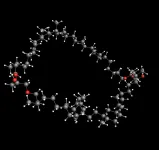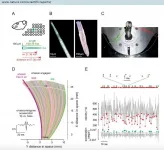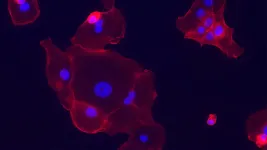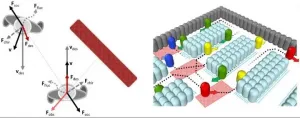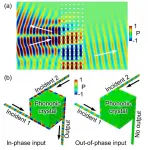(Press-News.org) Crenarchaeol is a large, closed-loop lipid that is present in the membranes of ammonium-oxidizing archaea, a unicellular life form that exists ubiquitously in the oceans. In comparison to other archaeal membrane lipids, crenarchaeol is very complex and, so far, attempts to confirm its structure by synthesizing the entire molecule have been unsuccessful. Organic chemists from the University of Groningen have taken up this challenge and discovered that the proposed structure for the molecule was largely, but not entirely, correct.
Crenarchaeol contains 86 carbon atoms and is a 'macrocycle, a large closed loop. No fewer than 22 positions in the molecule are chiral. The molecule can be present in two forms that are each other's mirror image, like a left and a right hand. In the crenarchaeol molecule, all 22 chiral centres have their own specific 'handedness'. Furthermore, crenarchaeol contains a very uncommon cyclohexane group.
Challenge
This complex molecule was first isolated in 2002 by Jaap Sinninghe Damsté and colleagues at the Royal Netherlands Institute for Sea Research, NIOZ. They identified its structure using spectroscopic techniques but their result has never been confirmed. This is surprising because ammonium-oxidizing archaea play a key role in the oceanic nitrogen cycle and fossil crenarchaeol and its companion lipids are widely used by molecular palaeontologists to reconstruct past sea temperatures. 'The structure of crenarchaeol is a formidable challenge for synthetic organic chemistry,' says Adri Minnaard, Professor of Organic Chemistry at the University of Groningen. 'And we decided to take it up.'
First, 3 milligrams of the natural compound were isolated and purified at NIOZ, which took about three months. There are only tiny amounts of crenarchaeol in each cell, just 0.000000001 gram, but because there are so many of these cells in the world's oceans and since the molecule is very stable and has accumulated in the sediment for millions of years, it is believed to be one of the most abundant organic molecules in marine sediments.
Mount Everest
There are several problems with synthesizing crenarchaeol; getting all the chiral centres in the correct orientation is one of them. 'And the molecule contains a lot of carbon-carbon bonds, which are difficult to construct.' But it is a challenge that a synthetic organic chemist cannot resist - just like an ambitious mountaineer cannot resist Mount Everest. Minnaard showed the structure to his PhD student Mira Holzheimer, who worked on palladium-catalyzed synthetic reactions. 'Her literal response was: "I want to climb that mountain".' They made a plan of attack on paper, which involved taking the molecule apart into the building blocks that could be synthesized. This produced a tentative route towards the synthesis of complete crenarchaeol molecules, which Holzheimer explored.
Similar to climbing a mountain for the first time, the synthetic route that they designed at the start sometimes led to a dead end. This meant retracing these steps and trying a new approach. 'You start with multiple grams of the basic compounds. But in each of the more than 65 intermediate steps, you lose material, sometimes up to 50 per cent. And if you run out of intermediates, you have to go all the way back again,' Minnaard explains.
Shock
After three years of hard work, Holzheimer had produced a large chunk of the molecule, roughly half of the macrocycle. Minnaard: 'At that stage, we decided to check it against the corresponding part of natural crenarchaeol.' This was done using coupled gas chromatography-mass spectrometry. The comparison was made at NIOZ and the results came as a shock: 'We synthesized the correct carbon skeleton, but the chromatographic behaviour was not the same as that for natural crenarchaeol. Something was wrong', Minnaard recalls.
After two days of checking, Minnaard and Holzheimer concluded that they really had made the proposed structure. And as it did not match completely with natural crenarchaeol, this could only mean one thing: the proposed structure was not entirely correct. The results pointed towards one of the chiral centres of the unusual cyclohexane group. 'Our collaborators at NIOZ mis-assigned just one chiral centre out of 22.' The structure correction was further supported by calculations on the spectra of both natural and prepared crenarchaeol, which were performed by Prof. Remco Havenith and Dr Ana Da Cunha. Minnaard: 'This shows the value of synthetic chemistry: building a proposed structure is the gold standard for validation.'
Art
Such a complex build as with crenarchaeol does bring some additional pay-offs: 'We had to develop new synthetic tools, that are now added to the organic synthesis toolbox.' Furthermore, having the correct structure is relevant for scientists who are studying archaeal membranes. This is usually done through molecular dynamics simulation, explains Minnaard, and the entirely correct structure is now available. Yet this pay-off is not the biggest motivation for Minnaard to take on these projects: 'It doesn't always have to have a purpose. To me, building molecules can be art.'
INFORMATION:
Reference: Mira Holzheimer, Jaap S. Sinninghe Damsté, Stefan Schouten, Remco W. A. Havenith, Ana V. Cunha, Adriaan J. Minnaard: Total Synthesis of the Alleged Structure of Crenarchaeol Enables Structure Revision, Angewandte Chemie, first online 11 juni 2021.
A new University of Iowa study suggests that metabolism of plant-based dietary substances by specific gut bacteria, which are lacking in patients with multiple sclerosis (MS), may provide protection against the disease.
The study led by Ashutosh Mangalam, PhD, UI associate professor of pathology, shows that a diet rich in isoflavone, a phytoestrogen or plant-based compound that resembles estrogen, protects against multiple sclerosis-like symptoms in a mouse model of the disease. Importantly, the isoflavone diet was only protective when the mice had gut microbes capable of breaking ...
MORGANTOWN, W.Va.--Just as helicopter traffic reporters use their "bird's eye view" to route drivers around roadblocks safely, radiation oncologists treating a variety of cancers can use new guidelines developed by a West Virginia University researcher to reduce mistakes in data transfer and more safely treat their patients.
Ramon Alfredo Siochi--the director of medical physics at WVU--led a task group to help ensure the accuracy of data that dictates a cancer patient's radiation therapy. The measures he and his colleagues recommended in their new report safeguard against medical errors in a treatment that more than half of all cancer patients receive.
"The most common mistake that happens in radiation oncology is the transfer of information from one system to another," Siochi, ...
How we sense texture has long been a mystery. It is known that nerves attached to the fingertip skin are responsible for sensing different surfaces, but how they do it is not well understood. Rodents perform texture sensing through their whiskers. Like human fingertips, whiskers perform multiple tasks, sensing proximity and shape of objects, as well as surface textures.
Mathematicians from the University of Bristol's Department of Engineering Mathematics, worked with neuroscientists from the University of Tuebingen in Germany, to understand how the motion of a whisker across a surface translates texture information into neural signals that can be perceived by the brain.
By carrying out high ...
Scientists have found new evidence of menopause in killer whales - raising fascinating questions about how and why it evolved.
Most animals breed throughout their lives. Only humans and four whale species are known to experience menopause, and scientists have long been puzzled about why this occurs.
Killer whales are a diverse species made up of multiple separate ecotypes (different types within a species) across the world's oceans that differ in their prey specialisation and patterns of social behaviour.
Previous studies have found menopause in an ecotype called "resident" killer whales whose social structure appears to favour "grandmothering" (females using their energy and knowledge ...
When a doctor gives a patient antibiotics for a bacterial infection, they usually require them to finish the entire treatment, even when symptoms go away. This is to ensure the drugs kill off any remaining bacteria. Cold Spring Harbor Laboratory (CSHL) Visiting Scientist Raffaella Sordella investigated a similar problem that occurs in some lung cancers.
Approximately 15% of non-small cell lung cancers have a mutation in a growth receptor called EGFR, causing tumor cells to grow uncontrollably. Researchers developed an effective drug that inhibits EGFR and ...
A Skoltech team has developed a model for assessing infection risks for supermarket customers. The researchers believe that their model will help formulate scientifically backed rules for safe shopping during the pandemic. The paper was published in PLOS One.
The team included professor Maxim Fedorov, who serves as Skoltech's Vice President for Artificial Intelligence and Mathematical Modeling, and a research group led by professor Nikolai Brilliantov -- the Director of the Skoltech Center for Computational and Data-Intensive Science and Engineering (CDISE).
The composite model presented in the paper incorporates ...
LEXINGTON, Ky. (July 13, 2021) -- A recently published study co-authored by University of Kentucky Sanders-Brown Center on Aging researcher Justin Miller, Ph.D., identifies 11 rare candidate variants for Alzheimer's disease. Researchers found 19 different families in Utah that suffered from Alzheimer's disease more frequently than what is considered normal.
Miller, an assistant professor in the UK College of Medicine, was a co-first author for the study published in the journal Alzheimer's & Dementia. The work was started at another university, however, some of the computational work was done after Miller arrived at UK in March.
For the study, genetic sequencing was conducted on two cousins from each of the 19 families. Miller says they then identified genetic variants that were shared ...
Automation of technology has reshaped both the way in which we work and how we tackle problems. Thanks to the progress made in robotics and artificial intelligence (AI) over the last few years, it is now possible to leave several tasks in the hands to machines and algorithms.
To highlight these advances, in the July 2021 issue, IEEE/CAA Journal of Automatica Sinica features six articles covering innovative applications of AI that can make our lives easier.
The first article, authored by researchers from Virginia Tech Mechanical Engineering Department ASIM Lab, USA, delves into an interesting mixture of topics: intelligent cars, machine learning, and electroencephalography (EEG). Self-driving cars have ...
The concept of topological phases have not only revolutionized our understanding of physics or materials, but also brought about new possibilities for applications. Recent advances in higher-order topological insulators show that multiple forms of topological states can exist at boundaries of different dimensions, which greatly enriched the potentials for diverse applications. Interesting, the topological phases can also be implemented in artificial structures in photonics, electromagnetism, and acoustics.
A recent work co-led by Dr. Guancong Ma from Hong Kong Baptist University and Dr. Ying Wu from King Abdullah University of Science and Technology explored the controlling sound propagation with topological modes at different dimensions. They designed and built ...
One in ten school-aged children in Australia have a current diagnosis of asthma. Every year, there are around 40,000 asthma hospitalisations and over 40 per cent of these are in children aged younger than 14 years old.
Approximately 80 per cent of these asthma-related hospital presentations are potentially avoidable through a standardised comprehensive care pathway for children with asthma.
These preventative measures include the use of evidence-based clinical guidelines, ensuring that there is an asthma action plan in place; regular follow-up with GP; provision of asthma education to parents/carers; and establishing ...
